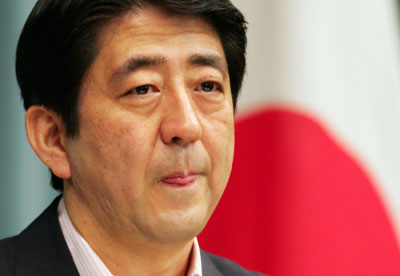Examining '3 arrows' in Abe's economics quiver
- By Joseph E. Stiglitz
 0 Comment(s)
0 Comment(s) Print
Print E-mail Shanghai Daily, April 9, 2013
E-mail Shanghai Daily, April 9, 2013
Japanese Prime Minister Shinzo Abe's program for his country's economic recovery has led to a surge in domestic confidence. But to what extent can "Abenomics" claim credit?
A closer look at Japan's performance over the past decade suggests little reason for persistent bearish sentiment. In terms of growth of output per employed worker, Japan has done quite well since the turn of the century.
|
|
|
Shinzo Abe [File Photo] |
With a shrinking labor force, the standard estimate for Japan in 2012 - that is, before Abenomics - had output per employed worker growing by 3.08 percent year on year. That is considerably more robust than in the United States, where output per worker grew by just 0.37 percent last year, and much stronger than in Germany, where it shrank by 0.25 percent.
Nonetheless, as many Japanese rightly sense, Abenomics can only help the country's recovery. Abe is doing what many economists (including me) have been calling for in the US and Europe: a comprehensive program entailing monetary, fiscal, and structural policies.
Abe likens this approach to holding three arrows - taken alone, each can be bent; taken together, none can.
The new governor of the Bank of Japan, Haruhiko Kuroda, comes with a wealth of experience gained in the finance ministry, and then as President of the Asian Development Bank. During the East Asia crisis of the late 1990s, he saw firsthand the failure of the conventional wisdom pushed by the US Treasury and the International Monetary Fund. Not wedded to central bankers' obsolete doctrines, he has made a commitment to reverse Japan's chronic deflation, setting an inflation target of 2 percent.
Weakened yen
Kuroda's stance has already weakened the yen's exchange rate, making Japanese goods more competitive. This simply reflects the reality of monetary-policy interdependence: if the US Federal Reserve's policy of so-called quantitative easing weakens the dollar, others have to respond to prevent undue appreciation of their currencies.
Monetary policy would have been more effective in the US had more attention been devoted to credit blockages - for example, many homeowners' refinancing problems, even at lower interest rates, or small and medium-size enterprises' lack of access to financing. Japan's monetary policy, one hopes, will focus on such critical issues.
But Abe has two more arrows in his policy quiver. Critics who argue that fiscal stimulus in Japan failed in the past - leading only to squandered investment in useless infrastructure - make two mistakes.
First, there is the counter-factual case: How would Japan's economy have performed in the absence of fiscal stimulus? Given the magnitude of the contraction in credit supply following the financial crisis of the late 1990s, it is no surprise that government spending failed to restore growth. Matters would have been much worse without the spending.
Second, anyone visiting Japan recognizes the benefits of its infrastructure investments.
The real challenge will be in designing the third arrow, what Abe refers to as "growth." This includes policies aimed at restructuring the economy, improving productivity, and increasing labor-force participation, especially by women.
Some talk about "deregulation" - a word that has rightly fallen into disrepute following the global financial crisis. In fact, it would be a mistake for Japan to roll back its environmental regulations, or its health and safety regulations.
What is needed is the right regulation. Government efforts to increase productivity in the service sector probably will be particularly important. For example, Japan is in a good position to exploit synergies between an improved health-care sector and its world-class manufacturing capabilities, in the development of medical instrumentation.
While Japanese students rank high in international comparisons, a widespread lack of command of English, the lingua franca of international commerce and science, puts Japan at a disadvantage in the global marketplace. Further investments in education are likely to pay high dividends.
There is every reason to believe that Japan's strategy for rejuvenating its economy will succeed: the country benefits from strong institutions, has a well-educated labor force with superb technical skills and design sensibilities, and is located in the world's most dynamic region.
It suffers from less inequality than many advanced industrial countries (though more than Canada and the northern European countries), and it has had a longer-standing commitment to environment preservation.
If the comprehensive agenda that Abe has laid out is executed well, today's growing confidence will be vindicated. Indeed, Japan could become one of the few rays of light in an otherwise gloomy advanced-country landscape.
Joseph E. Stiglitz, a Nobel laureate in economics, is university professor at Columbia University. Copyright: Project Syndicate, 2013.www.project-syndicate.org. Shanghai Daily condensed the article.







Go to Forum >>0 Comment(s)